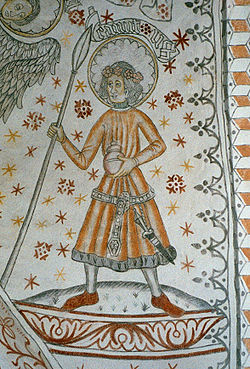Knud Lavard
| Saint Canute Lavard | |
|---|---|

Canute Lavard in a fresco in Vigersted Church near Ringsted.
|
|
| Martyr | |
| Born | 1096 Roskilde, Denmark |
| Died | 7 January 1131 forest of Haraldsted near Ringsted in Zealand, Denmark. |
| Venerated in | Roman Catholic Church |
| Canonized | 1169 by Pope Alexander III |
| Feast | 7 January |
| Attributes | knight with a wreath, lance, and ciborium |
| Patronage | Zealand, Denmark |
Canute Lavard (Danish: Knud Lavard) (March 12, 1096 – 7 January 1131) was a Danish prince. Later he was the first Duke of Schleswig and the first border prince who was both a Danish and a German vassal, a position leading towards the historical double position of Southern Jutland. Canute Lavard was also the ancestor of the Valdemarian Kings (Valdemarerne) and of their subsequent royal line. He was killed by his cousin Magnus, who saw him as a rival to the Danish throne, and was canonized in 1170.
Canute was the only legitimate son of Eric I of Denmark (+1103) and Boedil Thurgotsdatter but as a minor he was bypassed in the election of 1104. He grew up in close contact with the noble family of Hvide, who were later on to be among his most eager supporters. In 1115, his uncle, King Niels of Denmark, placed him in charge of the Duchy of Schleswig (jarl af Sønderjylland) in order to put an end to the attacks of the Slavic Obotrites. During the next fifteen years, he fulfilled his duty of establishing peace in the border area so well that he was titled Duke of Holstein (Hertug af Holsten) and became a vassal of the Holy Roman Empire.
He seems to have been the first member of the Danish royal family who was attracted by the knightly ideals and habits of medieval Germany, indicated by his changing his title to Duke of Schleswig (Hertug af Slesvig). His appearance made him a popular man and a possible successor of his uncle, but he also acquired mighty enemies among the Danish princes and magnates, who apparently questioned his loyalty and feared his bond with Emperor Lothair III, who had recognized him as sovereign over the western Wends. Whether these suspicions were just or not is impossible to say.
Both Niels and his son, Magnus the Strong, seem to have been alarmed by Canute's recognition by the emperor. On 7 January 1131, Canute was trapped in the (Haraldsted Skov) near Ringsted in Zealand and murdered by Magnus. Ringsted Abbey, one of the earliest Benedictine houses in Denmark, became the initial resting place of Canute Lavard. In 1157, Canute Lavard's remains were moved into a new chapel at St. Bendt's Church in Ringsted. A chapel (Knut Lavards Kapel) was erected at the site of his death during medieval times but disappeared after the Reformation. The ruins were rediscovered in 1883. In 1902 a memorial in the form of a 4-metre crucifix was erected near the site of the death of Canute Lavard.
...
Wikipedia
